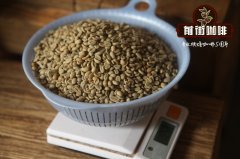Nicaraguan Coffee planting History Ancient Tree Nicaraguan Coffee Bean producing area Flavor characteristics and taste

History
Nicaragua began growing coffee in the late 1800s, but it was not until the mid-19th century that the crop became an important export: increased global demand (especially from North America) and reduced supply from the Pacific islands led to the steady development of the Nicaraguan coffee market, around this period, the first large plantations appeared in Managua, covering Jinotepe and Matagalpa. Genotega and New Segovia. The Nicaraguan government encourages European immigrants from Italy and Germany to buy land to buy coffee, most of which is controlled by white landowners until land is redistributed to produce small plots of land (usually less than 5 hectares). They often use local labour to exploit the land. Low wages and poor conditions.
Although its neighbours Costa Rica, El Salvador and even Guatemala began to become the origin of specialty coffee in the 1980s, Nicaragua's political and economic turmoil during the long Nicaraguan revolution (circa 1974-1990), as well as the destruction of hurricane Mitch in 1998, was one of the factors that separated the country from special concerns. From the 1980s to the early 1990s, the division of larger estates into small plots of land caused some confusion and disconnect between the agricultural sectors. The domestic work of the United States Agency for International Development and Fair Trade has helped to unify small producers into cooperatives and grower societies.
Nicaraguan coffee has traditionally been grown with excellent varieties, such as Typica,Bourbon,Caturra,Maragogype and other classic varieties, but at low elevations (800,900 masl), remote areas of small farms and the struggle against coffee leaves over the past decade, rust remains an obstacle to the country's clear and precious single-source identity. Nicaragua, the largest country in Central America, continues to maintain its reputation as the origin of coffee, but crops remain the most important, with exports exceeding US $1.2 billion, and about 15 per cent of the country's labour force is involved in the coffee sector.
Nicaragua mainly provides sources of full-container fair trade and organically certified coffee, but in recent years, we have been exploring different partnerships to seek more professional coffee from various producers or groups. even investigate the possibility of micro-batches. With the increase in altitude and the increasing interest of manufacturers in high-quality varieties and experimental processing, we see great potential in New Segovia.
Brief introduction of producer
Population involved in coffee-44000 producers
The average farm area is-1mi 14 hectares.
Bags exported each year-2.3 million bags (2016ax 2017)
Brief introduction of Nicaraguan Coffee
Planting area-Jinotega,Matagalpa,Nueva Segovia
Common varieties-bourbon, Catuai,Catimor,Caturra,Maracaturra,Maragogype
Treatment method-washed, some occasionally choose other treatment
Country-specific classification-SHG (strict planting), HG (strict planting)
Bag size-69kg
Harvest time-October to March
Typical arrival-April to July
Important Notice :
前街咖啡 FrontStreet Coffee has moved to new addredd:
FrontStreet Coffee Address: 315,Donghua East Road,GuangZhou
Tel:020 38364473
- Prev

The Road of Coffee Development in Colombia how Colombia has changed from drug production to boutique coffee
Colombia is rich in coffee production and has always been the second largest coffee producer only after Brazil. However, from 2003 to 2007, it was overtaken by Vietnam and is now the third largest coffee producer in the world. And more than 2 million people in Colombia depend on coffee production for a living, accounting for almost 1/4 of the domestic job market. Coffee is a very important cash crop! Colombian boutique
- Next

How about Starbucks breakfast beans? do breakfast beans taste sour?
Starbucks Breakfast Bean Story goes back to 1997, when Starbucks offered the lightest roasted coffee: House blend. When Starbucks seems to expand from the west coast of the United States to the east coast of the United States, it is found that there is a slight difference in coffee preferences between the east and west sides of the United States, so Starbucks wants to create a more active, more lightly roasted beans to satisfy the preferences of East Coast customers.
Related
- Detailed explanation of Jadeite planting Land in Panamanian Jadeite Manor introduction to the grading system of Jadeite competitive bidding, Red bid, Green bid and Rose Summer
- Story of Coffee planting in Brenka region of Costa Rica Stonehenge Manor anaerobic heavy honey treatment of flavor mouth
- What's on the barrel of Blue Mountain Coffee beans?
- Can American coffee also pull flowers? How to use hot American style to pull out a good-looking pattern?
- Can you make a cold extract with coffee beans? What is the right proportion for cold-extracted coffee formula?
- Indonesian PWN Gold Mandrine Coffee Origin Features Flavor How to Chong? Mandolin coffee is American.
- A brief introduction to the flavor characteristics of Brazilian yellow bourbon coffee beans
- What is the effect of different water quality on the flavor of cold-extracted coffee? What kind of water is best for brewing coffee?
- Why do you think of Rose Summer whenever you mention Panamanian coffee?
- Introduction to the characteristics of authentic blue mountain coffee bean producing areas? What is the CIB Coffee Authority in Jamaica?

